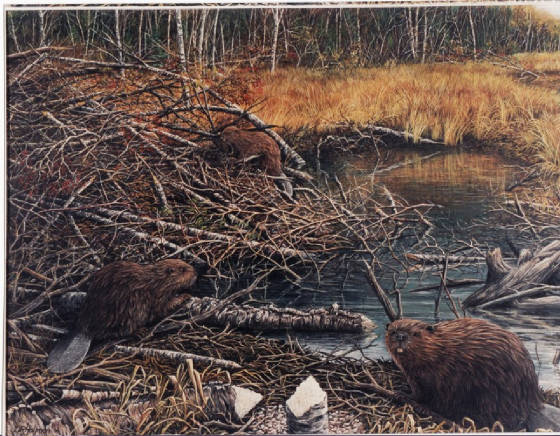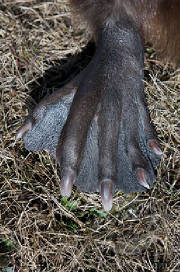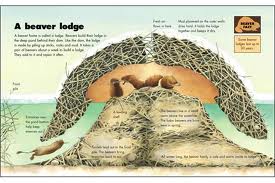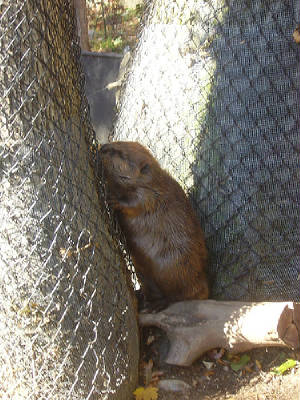|
|
 |
During the early days on the wild frontier, the beaver was a creature to be prized and was sought after for its
fur. Well, those days have long since past and now the beaver is becoming a major pest causing damage to property and the
environment. Due to the decline in demand for its fur, the beaver is no longer heavily pursued and its population has swelled.
Our local rivers and waterways are no exception.

|
| "Mother Natures" Carpenters at Work |
If all attempts to deter beaver from your land have failed, then removal of the problem animals may be necessary.
Trapping, even though landowners may be allowed to use traps to capture beaver, many individuals today are not familiar with
the technology nor do they possess the equipment and field skills necessary to be successful. Thus, trapping may best
be left to professionals. As a licensed trapper I am capable of deterring and or removing your wildlife problem.
|
 |
| A Beaver's Rear Foot |

|
Beavers today
are found throughout all of the North American continent. Here in Ohio, biologists believe beavers are present in almost every
county. Given their largesize and the limited amount of time they spend away from the protection of water, adult beavers have
relatively few natural predators. Because of the low natural mortality and an abundance of suitable habitat, Ohio's resident
beaver population currently is expanding, but the exact statewide population has not been estimated. Because human populations
continue to expand into more rural areas where beavers are more prevalent, humans are encountering beavers more often than
ever before. Thus, as beaver populations continue to expand into new habitats, many residents will be looking for ways to
control the damage caused by beavers

|
| A Beaver's Front Foot |
Because
human populations continue to expand into more rural areas where beavers are more prevalent, humans are encountering beavers
more often than ever before. Thus, as beaver populations continue to expand into new habitats, many residents will be looking
for ways to control the damage caused by beavers.
Physical damage caused by beavers in the Southeast is estimated in the millions of dollars annually. Examples
of this damage include timber and agricultural crop loss, damage to roads, septic systems and other property by flooding,
and destruction of ornamental plants used in landscaping.

A beaver may consume up to 20-30 oz. of food per day
(about equal to the bark and smaller branches of a 2-inch diameter tree every 2 days). They consume a wide variety of aquatic
plants and trees, including pine, red cedar, willow, alder, tulip poplar, red maple, dogwood, sweet gum, beech, and others
that grow near water. During spring and summer, beavers consume mostly grasses, sedges, rushes, some farm crops (e.g., soybeans,
corn), and the succulent new growth of small bushes. As winter approaches, they switch more to woody material.
|
 |
|
|
|
 |
To reduce the potential for damage to personal property, precautions should be taken before a beaver
develops an interest in your property. As with most wildlife damage problems, no single technique exists that will provide
absolute protection from beaver depredations. However, certain measures that are initiated in a timely fashion, maintained
properly, and applied with an understanding of the habits or behaviors of beavers can reduce the likelihood of significant
damage.
People
residing within the beaver's range (primarily owners of shoreline property) should recognize that beavers are clever and persistent
animals and they may be able to circumvent some of the control techniques mentioned below. Therefore, anyone affected by beavers
must be willing to implement a comprehensive management strategy involving multiple techniques
| A Typical Desiogn of a Beaver's Lodge |

|
Ro-pelŪ would be most effective when used at the first indication
of beaver presence or in areas where beavers are most actively feeding. However, as is true with many other repellents, frequent
reapplication may be required to maintain best results.Non-lethal controls
used to deter beavers can be expensive and require substantial investment of time by a landowner to put them into use.
Examples include the use of fencing and water leveling devices.
| Fencing to Deter Beavers from Trees |

|
Return To Wildlife's Home Page
|
 |
|
|
|
|
|
|
|
 |

